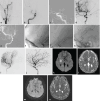Non-routine thrombectomy in pediatric arterial ischemic stroke
- PMID: 38836435
- PMCID: PMC12057539
- DOI: 10.4274/dir.2024.242675
Non-routine thrombectomy in pediatric arterial ischemic stroke
Abstract
Purpose: Unlike in adults, the indications and techniques for mechanical thrombectomy for arterial ischemic stroke (AIS) in children are not clearly established. The medical and interventional management of children with acute large vessel occlusion may entail the modification of the standardized management of this condition in adults. We present six cases of children who underwent non-routine thrombectomy for AIS.
Methods: We retrospectively reviewed the records of children diagnosed with AIS between 2015 and 2023 and evaluated patient characteristics, procedural technical data, and final clinical outcomes. Procedures deviating from the current definition and indications for AIS treatment in adults as well as previously reported pediatric thrombectomy cases were defined as non-routine thrombectomy.
Results: Seven non-routine thrombectomy procedures in six children were included in the study. The National Institutes of Health Stroke Scale scores on admission ranged from 4 to 35; no procedure-related mortality or major neurologic morbidity occurred. One child died of causes related to the initial severe heart failure and stroke; otherwise, all the children had a modified Rankin scale score of 0 to 1 at follow-up. Unique clinical and procedural features in our case series included presentation with acute stent occlusion (two children), bilateral simultaneous internal carotid artery occlusions associated with a unilateral tandem middle cerebral artery (MCA) occlusion (one child), MCA occlusion caused by thromboembolism of the atrial myxoma (one child), and very distal (one child) or delayed thrombectomy (two children).
Conclusion: Modifications to the standard medical and interventional algorithms may be required for mechanical thrombectomy in children.
Clinical significance: Referral centers specialized in pediatric neurology, pediatric anesthesia, and pediatric intervention are optimal for treating children using mechanical thrombectomy and for modifying the treatment, if required.
Keywords: Stroke; aspiration; children; stent; thrombectomy; thrombolysis.
Copyright© Author(s) - Available online at dirjournal.org. Content of this journal is licensed under a Creative Commons Attribution-NonCommercial 4.0 International License.
Conflict of interest statement
Conflict of interest disclosure: The authors declared no conflicts of interest.
Figures


Similar articles
-
Mechanical thrombectomy using a Solitaire stent retriever in the treatment of pediatric acute ischemic stroke.J Neurosurg Pediatr. 2019 Mar 1;23(3):363-368. doi: 10.3171/2018.9.PEDS18242. Epub 2019 Jan 4. J Neurosurg Pediatr. 2019. PMID: 30611154
-
Management of acute ischemic stroke due to tandem occlusion: should endovascular recanalization of the extracranial or intracranial occlusive lesion be done first?Neurosurg Focus. 2017 Apr;42(4):E16. doi: 10.3171/2017.1.FOCUS16500. Neurosurg Focus. 2017. PMID: 28366065
-
Endovascular treatment of distal medium vessel occlusions using microcatheter aspiration thrombectomy.Interv Neuroradiol. 2024 Apr;30(2):234-241. doi: 10.1177/15910199221133470. Epub 2022 Oct 19. Interv Neuroradiol. 2024. PMID: 36259323 Free PMC article.
-
Mechanical thrombectomy with Solitaire stent for acute internal carotid artery occlusion without atherosclerotic stenosis: dissection or cardiogenic thromboembolism.Eur Rev Med Pharmacol Sci. 2014;18(9):1324-32. Eur Rev Med Pharmacol Sci. 2014. PMID: 24867510 Review.
-
Revascularization of tandem occlusions in acute ischemic stroke: review of the literature and illustrative case.Neurosurg Focus. 2017 Apr;42(4):E15. doi: 10.3171/2017.1.FOCUS16521. Neurosurg Focus. 2017. PMID: 28366063 Review.
Cited by
-
Etiologic spectrum and neurological outcomes in pediatric arterial ischemic stroke and cerebral sinovenous thrombosis: A 15-Year retrospective study at a tertiary hospital.Acta Neurol Belg. 2025 Jun;125(3):757-770. doi: 10.1007/s13760-025-02753-8. Epub 2025 Mar 14. Acta Neurol Belg. 2025. PMID: 40085411
References
-
- Mallick AA, O’Callaghan FJ. The epidemiology of childhood stroke. Eur J Paediatr Neurol. 2010;14(3):197–205. - PubMed
-
- Mallick AA, Ganesan V, Kirkham FJ, et al. Diagnostic delays in paediatric stroke. J Neurol Neurosurg Psychiatry. 2015;86(8):917–921. - PubMed
-
- Barry M, Hallam DK, Bernard TJ, Amlie-Lefond C. What is the role of mechanical thrombectomy in childhood stroke? Pediatr Neurol. 2019;95:19–25. - PubMed
MeSH terms
LinkOut - more resources
Full Text Sources
Medical

